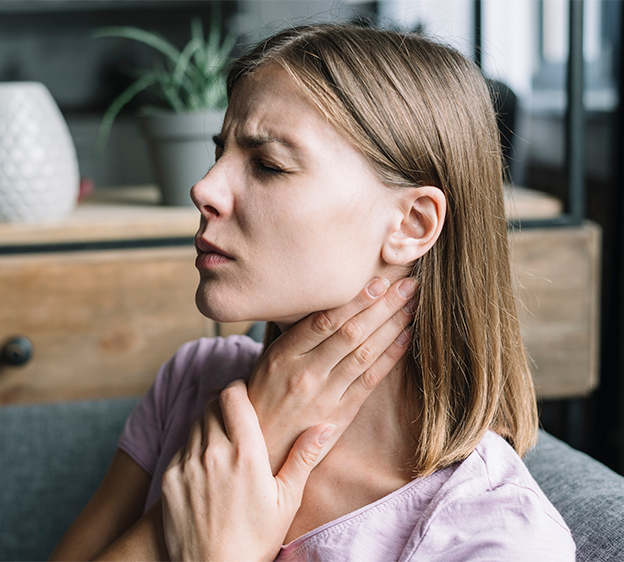
Post-nasal drip is a common condition that can lead to several uncomfortable symptoms. It can be a sign that a sinus infection, flu or other illness may be developing. It occurs when excess mucus builds up in the back of your nose and throat, leading to a sore throat and coughing.
In most cases, post-nasal drip is not dangerous but can be bothersome. Knowing its triggers, how to treat it from home and when to seek medical care can help you find relief.
What is Post-Nasal Drip?
Glands in the nose and throat typically produce mucus. But when you get sick, the body secretes more mucus than normal, draining down the back of your nose and throat — resulting in post-nasal drip.
“When your sinuses are functioning properly, mucus helps trap debris and moisten the nasal passages and doesn’t enter the back of your throat,” explains James Varner, board-certified physician assistant at Beaufort Memorial Lowcountry Medical Group Primary Care. “But post-nasal drip can indicate an underlying issue causing excess mucus production or inflammation in the nasal passages.”
Common symptoms of post-nasal drip include:
- A persistent cough that often worsens at night, including a dry cough
- A sore throat or hoarseness
- Bad breath
- The sensation of mucus dripping or draining down the back of your throat
- The need to clear your throat frequently
Read More: Sinus Infection? How to Relieve the Pressure
Causes of Post-Nasal Drip
Common triggers leading to post-nasal drip include:
- Allergies: Seasonal allergies to pollen, mold or dust can irritate the nasal passages and cause mucus overproduction.
- Bacterial infections: Sinus infections caused by bacteria can lead to an overproduction of mucus that gets stuck and drips down your throat.
- Environmental factors: Dry air, pollution, smoke and other irritants can inflame nasal passages and produce excess mucus.
- Gastroesophageal reflux disease (GERD): Stomach acid from GERD can lead to post-nasal drip.
- Upper respiratory viruses: Post-nasal drip is a common symptom of an upper respiratory virus, as the body continues to clear out mucus and inflammation from the respiratory system.
Why Post-Nasal Drip Often Follows Illness
Post-nasal drip occurs frequently following a viral infection, such as the influenza virus, COVID-19 or other upper respiratory viruses. Your body continues to produce mucus as it heals, and excess mucus then can lead to post-nasal drip, resulting in throat irritation and coughing.
How to Get Rid of Post-Nasal Drip
There are effective home treatments you can use to reduce your symptoms, including:
- Gargle with salt water: This simple remedy can soothe a sore throat and clear mucus buildup in the back of the throat.
- Over-the-counter medications: Decongestants can relieve a stuffy nose by shrinking swollen nasal tissues. Acetaminophen or ibuprofen can help with body aches or any discomfort related to a sore throat. Antihistamines are helpful if allergies are contributing to your post-nasal drip.
- Sleep with your head elevated: Keeping your head propped up with pillows can prevent mucus from pooling in your throat.
- Stay hydrated: Drinking plenty of fluids helps thin mucus. Water, tea and broth are excellent choices.
- Use a humidifier or steam: Adding moisture to the air prevents your nasal passages from drying out.
- Use a saline nasal spray. This can help moisturize dry nasal passages and flush out irritants or allergens contributing to excess mucus production.
“Post-nasal drip isn’t usually indicative of something serious and can generally be treated at home,” Varner says. “Stay diligent and try at-home remedies, but if you don’t experience significant improvement within 10 days, contact your primary care provider.”
When to Seek Medical Care
Post-nasal drip isn’t usually severe, but there are situations where it’s essential to see a health care provider, especially if symptoms don’t improve in a reasonable amount of time — within 10 days or less — using at-home treatment. If you notice any of the following issues, get medical attention:
- You experience thick, yellow or green mucus, which may indicate a bacterial infection.
- You develop a fever or flu-like symptoms such as severe body aches or persistent cough.
- You have difficulty breathing or notice other respiratory issues that worsen over time.
Left untreated, a bacterial infection can lead to more severe complications, so it's important to monitor symptoms and consult a health care provider if you're concerned.
“A bacterial infection needs to be diagnosed by a doctor,” Varner says. “It can result in serious health problems if you don’t treat it properly. If you suspect that’s what’s going on, see your primary care provider as soon as possible. Antibiotics are most likely needed to get rid of the infection.”
Read More: Coming Down With the Crud?
Can I Prevent Post-Nasal Drip?
You can help prevent post-nasal drip by not getting sick, and that means preventing viral illness. Here are some tips to avoid the viruses and irritants that can cause post-nasal drip:
- Avoid irritants: Stay away from cigarette smoke, strong odors and pollution that can irritate your nasal passages.
- Maintain good hygiene: Wash your hands regularly and avoid close contact with sick people to prevent viral infections.
- Stay current on your vaccinations for viral illnesses: Vaccines for COVID-19 and influenza (the flu) can protect you from these viruses, often leading to post-nasal drip.
- Treat allergies: Use antihistamines and nasal sprays to manage seasonal allergies that could lead to post-nasal drip.
Understanding what triggers post-nasal drip and how to treat it can help you manage your symptoms more effectively. If you think you’re sick, staying at home is the best way to prevent others from getting sick and help you rest and recover, too.
Start a Video Visit or find an Express Care Clinic near you.

